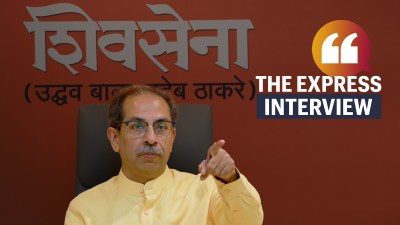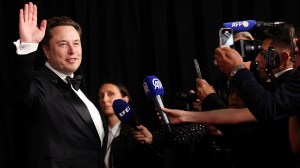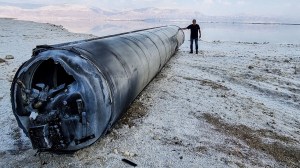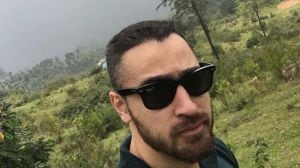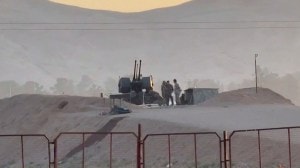- India
- International
‘The current political situation and events have affected us deeply’
Ranbir Kaleka, one of India’s finest contemporary multimedia artists, spoke to The Indian Express about his passions, inspirations and his art.
 The enormity of nature and the miniscule signs of human presence within it have held a fascination for me, says Ranbir Kaleka. (Express)
The enormity of nature and the miniscule signs of human presence within it have held a fascination for me, says Ranbir Kaleka. (Express)
Written by Audita Bhattacharya
Ranbir Kaleka, one of India’s finest contemporary multimedia artists, recently created a mural for a premier hotel in Pune. The artist spoke to The Indian Express about his passions, inspirations and his art. Excerpts from the interview:
Tell us about the inspiration behind the mural. What does it depict for you as an artist and how do you expect viewers to see it?
The densely-peopled paintings of two masters — Bruegel’s (Renaissance painter and printmaker Pieter Bruegel the Elder) everyday world of ordinary people and Bosch’s (Dutch painter Hieronymus Bosch) medieval fantastical nightmarish creations — have both afforded a riveting experience. Innumerable events happening in a single pictorial space are also seen in Indian miniature paintings. We see them in a masterpiece of early Renaissance secular painting, The Allegory of Good and Bad Government by Lorenzetti (Italian painter Ambrogio Lorenzetti). Exposure to such works can be seen as an influence on my work. I have woven the “fantastical” as well as the “everyday” into the composition. In the tradition of murals, aspects of the hotel’s architecture are incorporated into the artwork. The arch and floor of the hotel form a stage for a theatrical performance by diverse characters. I have aimed at bringing the monumental and the intimate in a theatrical staging of events.
What did you do to familiarise yourself with Pune before creating this artwork?

In the mid 1970s, I spent a month in Pune. Later, I visited the city a few times for short periods. This time, Sandeep Chatterjee, a professor at FTII (Film and Television Institute of India) took me around Pune along with a student of his. I took photographs of historical structures and statues in various parts of the city. These images are, however, moulded, shaped and coloured to suit the visual demands of the artwork. A couple of historical characters are included as well as some elements from beyond the actual city.
 The mural by artist Ranbir Kaleka at the hotel in Pune. (Express)
The mural by artist Ranbir Kaleka at the hotel in Pune. (Express)
What are the various aspects that you have focused on?
The enormity of nature and the miniscule signs of human presence within it have held a fascination for me. I combine large and tiny elements in my artworks. In this one, you will see a herder with his buffalo on the outskirts of Pune; he is about 3 cm tall in a more than 1,00,000 sq cm artwork. Large or small, each object and figure live within a personalised space. There are several small details, such as a burnt matchstick and two wedding rings. Each viewing will be rewarded with something new. The artwork has to be allowed to appeal through your senses and then a willingness to reflect on your own feelings will allow the viewer to imbue the artwork with personal invented stories.
Your work ranges from surrealist, yet minimalist, pieces such as Cul de Sac, House of Opaque Water, He was a Good Man, to more vibrantly whimsical pieces such as Freedom of Flight, Acts of Elegance. As an artist, that is a wide spectrum to work on.
These are two different streams of work. The first body of work are video installations; they involve video projections on canvas painted in oils, or they are multichannel video projections on varied surfaces and planes. These works are an exploration of visual language involving the corporeality of the still painted image and the moving image made of insubstantial light. Here cinematic time and time as it sits in a painting come into play. The larger body of digital painting/collages are more fanciful and fantastical where fairytale and mundane life come together. The works closer to me could be described as works of magic realism and not as much surrealist.
There are recurring motifs of animal themes, specifically the lion, the tiger and the leopard, along with tones of sexuality and tradition. Any particular reason behind these recurring motifs?
There was one body of work related to sexuality on which I worked for a few years. I wanted to see if frontal nudity and states of arousal could make for works of psychological complexity. Animals and birds primarily came into my digital painting/collages when I started making works for a charity in Delhi. Various species are endangered today. Bringing in animals and birds as sentient beings opens up a new mental and dramatic space in the artworks. It also allows for greater figural configurations and compositional play.
Art is often known to mirror reality. Would you call your art political?
Here we are referring more to my video installations and some paintings. The question to ask is where does a work of art come from. It comes from lived life, from what impacts you. It takes from art history, cinema, literature, poetry, theatre or even stories told by people. I don’t think there ever really were good old times. That’s why in some great literature and works of art, darkness has been a crucial source. It also comes from the possibility of redemption, because one can’t live entirely with darkness, and, if one could, one wouldn’t be self-reflective when making art. In my recent exhibition ‘Fear Of A New Dawn’, one awakens to a sense of fear. The video installation Not Anonymous_Waking to the Fear of a New Dawn is in black and white and when everything disappears in a landscape charred by flames, we see a tiny green sapling on the edge of the installation swaying in the breeze. The current political situation and the events in the recent past have affected us deeply. I remember, as a student in London, one of my professors was looking at an oil painting of a hellscape by another student. My professor asked him if his painted image frightened him, and said if it didn’t, it was stupid to paint it. So, the fear has to happen to you. The urge to make the work has to come from within the artist.
Click here to join Express Pune WhatsApp channel and get a curated list of our stories
Apr 20: Latest News
- 01
- 02
- 03
- 04
- 05











